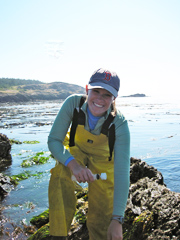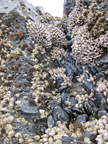Nitrogen-Driven Interactions in Rocky Shore Seaweed-Microbe Interactions: Competition or Facilitative Sharing?
By Orissa Moulton, PhD Candidate,
University of Chicago Dept. of Ecology & Evolution
 All plants require nitrogen for growth, yet few can assimilate abundant atmospheric nitrogen gas. As such, nitrogen is a common limiting factor for plant and algal growth in the ocean and on land. In general, seaweeds can utilize three forms of nitrogen: nitrate, ammonium, and nitrite. Ocean subsidies deliver nitrate via upwelling, and this form of nitrogen dominates the total available nitrogen-pool. Marine animals excrete nitrogen in the form of ammonium. Also present in these systems are myriad microbial species, including nitrifying microbes. Nitrifying microbial communities associated with animals utilize ammonium to produce nitrite and nitrate. Nitrification is thus a process that puts microbes in competition with algae for ammonium nitrogen. Despite the potential for competition between microbes and algae, algae benefit from animal-regenerated nitrogen even in the presence of a rich microbial assemblage, suggesting that microbes could also serve to facilitate algae via retention of nitrogen in a useable form in a high-energy environment. My PhD research explores indirect interactions among marine rocky intertidal organisms via the nitrogen cycle, a limiting nutrient for productivity. My work will provide insight into nitrogen-based ecosystem services provided by animal communities. I ask two main questions in my work:
All plants require nitrogen for growth, yet few can assimilate abundant atmospheric nitrogen gas. As such, nitrogen is a common limiting factor for plant and algal growth in the ocean and on land. In general, seaweeds can utilize three forms of nitrogen: nitrate, ammonium, and nitrite. Ocean subsidies deliver nitrate via upwelling, and this form of nitrogen dominates the total available nitrogen-pool. Marine animals excrete nitrogen in the form of ammonium. Also present in these systems are myriad microbial species, including nitrifying microbes. Nitrifying microbial communities associated with animals utilize ammonium to produce nitrite and nitrate. Nitrification is thus a process that puts microbes in competition with algae for ammonium nitrogen. Despite the potential for competition between microbes and algae, algae benefit from animal-regenerated nitrogen even in the presence of a rich microbial assemblage, suggesting that microbes could also serve to facilitate algae via retention of nitrogen in a useable form in a high-energy environment. My PhD research explores indirect interactions among marine rocky intertidal organisms via the nitrogen cycle, a limiting nutrient for productivity. My work will provide insight into nitrogen-based ecosystem services provided by animal communities. I ask two main questions in my work:
1. Is the relationship between nitrogen-utilizing microbes and seaweeds competitive (negative) or facilitative (positive) in terms of a shared resource, ammonium?
2. How do rocky intertidal microbial communities vary at landscape scale and across a gradient of faunal nitrogen input?
To investigate the range of possible interactions between microbial activities and intertidal algae in the presence of ammonium, their shared resource, I have designed a laboratory mesocosm experiment (IMAGE 2) .My design varies both ammonium availability and microbial load. I increase microbial load in some treatments using BioBalls, which are 1" in diameter and made of high surface area sinking plastic material. These structures were designed for aquarists to metabolize ammonium waste from fish tanks using nitrifying microbes. I increase ammonium concentrations using a concentrated ammonium chloride gravity drip into some treatments. Ammonium chloride in this concentration is biologically realistic for mussel excretory products in the intertidal zone. In my mesocosms, microbial communities have opportunity to 'interact' with seawater and added NH4 before flow reaches algae.I measure several response variables in terms of nitrogen use in my mesocosms, including nitrogen water chemistry (Ammonia, Nitrite, Nitrate) measured throughout experimental period.I also track growth responses in two algal species known to grow faster at elevated ammonium concentrations, including growth rate and tissue nitrogen content.
.My design varies both ammonium availability and microbial load. I increase microbial load in some treatments using BioBalls, which are 1" in diameter and made of high surface area sinking plastic material. These structures were designed for aquarists to metabolize ammonium waste from fish tanks using nitrifying microbes. I increase ammonium concentrations using a concentrated ammonium chloride gravity drip into some treatments. Ammonium chloride in this concentration is biologically realistic for mussel excretory products in the intertidal zone. In my mesocosms, microbial communities have opportunity to 'interact' with seawater and added NH4 before flow reaches algae.I measure several response variables in terms of nitrogen use in my mesocosms, including nitrogen water chemistry (Ammonia, Nitrite, Nitrate) measured throughout experimental period.I also track growth responses in two algal species known to grow faster at elevated ammonium concentrations, including growth rate and tissue nitrogen content.
To probe biogeochemical cycling and the functional capacity of animals and microbes in nature, I have begun to compare three sites in the San Juan Islands known to vary strongly in rocky intertidal community composition: Westside Preserve, San Juan Island (kelp-dominated), Iceberg Point, Lopez Island (IMAGE 3) (sessile invertebrate-dominated) (IMAGE 4), and Indian Island, Eastsound, Orcas Island (algal-dominated with abundant sea stars). I will use genetic sequencing techniques to examine the taxonomy of the microbial community on BioBalls installed at all three sites, and will pair these finding withanalyses of local water chemistry and algal tissue composition to track regional patterns in nitrogen-cycle chemistry.
I will use genetic sequencing techniques to examine the taxonomy of the microbial community on BioBalls installed at all three sites, and will pair these finding withanalyses of local water chemistry and algal tissue composition to track regional patterns in nitrogen-cycle chemistry.
Improved knowledge of natural nitrogen-cycling and development of a predictable nitrogen budget for primary producers will allow for better protection of the temperate coastlines, where fisheries are most developed. Understanding the responses of microbes and seaweeds to changing globally changing environmental factors (e.g., temperature, pH, N-availability) will improve our ability to predict specific responses of rocky intertidal microbes, including community composition and function shifts. In the future, my findings will inform marine reserve effectiveness. I predict that an intact animal community will affect nitrogen cycling differently than an overharvested animal community. My work will gauge effectiveness of restricted-use marine reserves for ecosystem-scale nitrogen cycling and disentangle linkages between ecosystem function and environmental context.

Author:
Orissa Moulton received a B.A. in Biology from Wheaton College (Norton, MA) in 2007. In 2010, she completed a M.S. degree in Zoology at Oregon State University, researching sea grass community ecology under Dr. Sally Hacker. Orissa is now a Ph.D. candidate in Ecology & Evolution at the University of Chicago, working with Dr. Cathy Pfister. Orissa studies intertidal marine community ecology, especially ecology pertaining to the nitrogen cycle. She is a Summer 2012 Alan & Marian Kohn Graduate Fellow at Friday Harbor Labs, studying how seaweeds and microbes interact in the presence of ammonium, a shared resource.
Photos:
Image 1: Orissa Moulton sampling water at Iceberg Pt., Lopez Island (Photo Credit Nick Colvard)
Image 2: Mesocosms at Friday Harbor Labs (Photo Credit Orissa Moulton)
Image 3: a. Iceberg Pt., Lopez Island (Photo Credit Orissa Moulton); b. Barnacles & mussels at Iceberg Pt. Lopez Island (Photo Credit Orissa Moulton)
Image 4: BioBall pouch at Iceberg Pt., Lopez Island; white PVC quadrat is ½ m x ½ m (Photo Credit Orissa Moulton)

